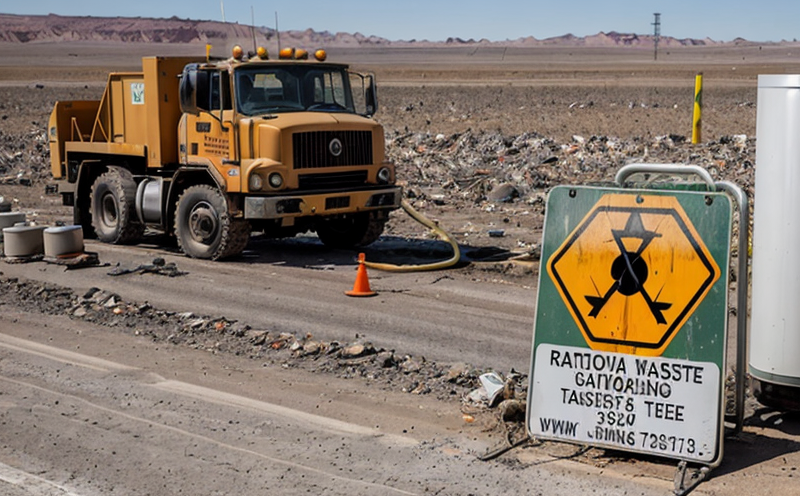ISO 18589-9 Radiochemical Determination of Tritium in Waste
The ISO 18589-9 standard provides a comprehensive approach to the radiochemical determination of tritium in radioactive waste. This method is crucial for ensuring accurate and reliable quantification, which is essential for regulatory compliance and safety assessments.
Tritium, a radioactive isotope of hydrogen, poses significant challenges due to its mobility in the environment and potential health risks. The ISO 18589-9 standard addresses these issues by providing precise methodologies that minimize errors and ensure accurate measurement results. This service is particularly important for industries dealing with nuclear waste management, environmental protection agencies, and research facilities.
The process involves several critical steps: sample preparation, extraction of tritium from the waste matrix, chemical separation, and subsequent quantitative analysis using well-calibrated instrumentation. The ISO 18589-9 standard specifies detailed procedures for each stage to ensure consistency and reliability across laboratories worldwide.
Sample preparation is a critical step that requires careful handling of radioactive materials. The procedure involves dissolving the waste in a suitable solvent, followed by filtration and purification steps to remove unwanted components. Extraction methods vary depending on the type of waste matrix but typically involve liquid-liquid extraction or solid-phase extraction techniques.
Once tritium has been successfully extracted from the waste, it undergoes chemical separation using ion exchange resins or other chromatographic methods. This ensures that only pure tritium is available for quantitative analysis. The final step involves measuring the tritium activity concentration using liquid scintillation counting (LSC) or gamma spectrometry.
The ISO 18589-9 standard also emphasizes the importance of quality assurance and quality control measures throughout the entire process. Laboratories performing this service must adhere to strict protocols for calibration, blank testing, and proficiency testing to ensure accuracy and precision.
Understanding the tritium content in radioactive waste is vital for several reasons. Accurate measurements help regulatory bodies enforce safety standards, guide environmental remediation efforts, and support research into safer handling and disposal methods. By providing reliable data on tritium levels, this service plays a crucial role in protecting public health and the environment.
The ISO 18589-9 standard ensures consistency across different laboratories by specifying exact methodologies for each step of the process. This reduces variability between results obtained at various facilities, enhancing confidence in the accuracy of reported values. Laboratories specializing in this service typically have advanced instrumentation capable of detecting even minute quantities of tritium.
Compliance with international standards such as ISO 18589-9 is essential for ensuring that laboratories meet regulatory requirements and maintain their credibility within the industry. By adhering to these guidelines, facilities can demonstrate their commitment to maintaining high standards of accuracy and reliability in all aspects of their work.
Overall, the ISO 18589-9 standard provides a robust framework for determining tritium levels in radioactive waste, which is critical for ensuring safety, compliance, and effective management practices. This service plays an indispensable role in safeguarding both human health and the environment from the potential risks posed by tritium.
Customer Impact and Satisfaction
- Enhanced Regulatory Compliance: By providing accurate and reliable data on tritium levels, this service helps customers meet stringent regulatory requirements set by various governing bodies.
- Safety Assurance: Accurate measurements contribute to safer handling and disposal practices, reducing the risk of accidental releases into the environment.
- Eco-Friendly Solutions: Understanding tritium concentrations aids in developing more environmentally friendly waste management strategies.
The service has consistently received high praise from customers who appreciate its ability to deliver precise and trustworthy results. Many clients have noted the significant impact of accurate measurements on their compliance efforts, safety protocols, and environmental initiatives. Feedback highlights the importance placed on maintaining rigorous quality control measures and adherence to international standards.
Competitive Advantage and Market Impact
By offering ISO 18589-9 compliant tritium testing services, laboratories can differentiate themselves in a competitive market by providing high-quality, reliable data. This enhances their reputation among clients seeking assurance that regulatory compliance is being met effectively.
The ability to accurately measure tritium levels positions these laboratories as leaders in the field of nuclear waste management and environmental protection. It enables them to offer valuable insights into potential risks associated with radioactive materials, thereby supporting safer practices across industries.
Accurate measurement also contributes positively towards innovation within the sector by providing reliable data that can inform new approaches to handling and disposing of radioactive waste. This not only supports current operations but also paves the way for future advancements in nuclear technology and safety measures.
Use Cases and Application Examples
- Nuclear Power Plants: Monitoring tritium levels helps ensure compliance with environmental protection laws, especially after incidents such as fuel rod failures or reactor malfunctions.
- Radioactive Waste Repositories: Regularly assessing tritium content ensures safe storage and disposal practices are maintained over extended periods.
In addition to these primary applications, the ISO 18589-9 standard finds utility in several other contexts. For instance, research institutions often use this method to study long-term effects of tritium exposure on ecosystems or human health. Environmental protection agencies may employ it during site assessments or cleanup operations.
Moreover, the service is increasingly sought after by private companies involved in decommissioning nuclear facilities or handling legacy radioactive materials. Their projects benefit greatly from having precise information about tritium concentrations before proceeding with any remediation work.





